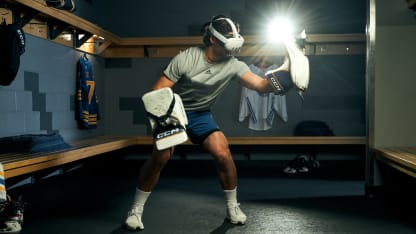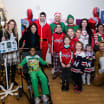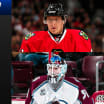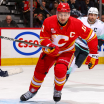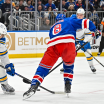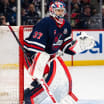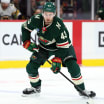Joey Daccord wasn’t feeling great about his glove hand after the first period of a start with the Seattle Kraken earlier this season, so when he got back to the locker room he put on his virtual reality headset so he could catch some computer-generated pucks during the intermission.
Daccord loaded up a program called NHL Sense Arena and started a drill called the Goalie Cannon, which allows him to control exactly where the virtual shots are heading.
“I didn’t feel like I was super dialed [in] with my glove, like my glove was as clean as I want it to be,” he said. “So, I turned it on, lined it up to do high glove, middle glove, low glove and just caught a bunch of pucks in the intermission, and then I went back out and my glove felt better.”
If the idea that making saves in virtual reality can help an NHL goalie mid-game is surprising to some, it certainly isn’t to Daccord, who uses NHL Sense Arena as part of his preparations before every game he’s scheduled to start. That includes everything from position-specific cognitive drills to making saves off both computer-generated shooters and actual NHL shooters.
“I usually start with some of the cognitive warmup drills that get your brain firing,” Daccord said, “and then I get into the Goalie Cannon, which is a drill where I can dictate exactly where I want the shot to come from and where I want it to go. I use that as a warmup to dial in my mechanics, make sure I'm making every single blocker save and glove save perfectly.
"One of the cool things about Sense Arena is you can see exactly where the puck hit your blocker. It lights up green exactly where the puck mark is, so I try to make sure every shot goes perfectly in the pocket of my glove or dead center on my blocker. From there, I move into the video drills with real shooters, NHL shooters, doing drills, and right before the puck gets to you it switches from a real puck to a virtual puck.”
Daccord’s training plan and game-day routine are available for others to try within the program, which recently was rebranded from Sense Arena to NHL Sense Arena as part of a partnership with the League that allows users to dress up their virtual selves as a member of -- and play against -- all 32 NHL teams. The idea is to bring goalies, whether from youth leagues or beer leagues, onto NHL ice surfaces and right into NHL locker rooms, but the reality is Sense Arena was already there.
Buffalo Sabres goalie Devon Levi was the face of that Nov. 1 relaunch, and he and Daccord have been the most active in-season NHL users of the product, but other goalies in the League have also used it in the offseason or when they can’t get onto the ice as often as they would like.
Levi was introduced to NHL Sense Arena while he was with Canada at the 2021 IIHF World Junior Championship and was forced to quarantine in a hotel for an extended period. It gave him a way to stay sharp, and he continued using it at Northeastern University and now in the NHL.
"I use it to take shots, see pucks, and just get warm,” Levi said. "I use it on off days, if I want to get on the ice but there is no ice. I've also used it when I was injured when I'm not able to get into the gear. I still have the opportunity to go get pucks, go see pucks, go read releases.”
Those releases really are coming from NHL shooters in the video drills that Daccord referenced. After starting with European pros for the initial 2018 launch, the Czech Republic-based company filmed undisclosed NHL players shooting pucks to create the videos used for those drills and converted that footage into virtual pucks as they come toward the goalie in a VR headset.
“Those are the best ones in my opinion,” Daccord said of the video drills, “where you're seeing shots off of an NHL stick, and I think there's a huge benefit to just reading releases.”
As Daccord did between periods, goalies also have the option of telling those virtual players where to shoot, and they’ll do so a lot more reliably and consistently than even NHL shooters in practice, allowing goalies to dial in on specific save mechanics. The program tracks results and includes diagnostic tools like play- and puck-tracking percentages, but also allows goalies to watch replays.
Sabres goalie Eric Comrie primarily uses NHL Sense Arena in the offseason or when he’s injured and can’t get onto the ice. He likes that the replays that allow him to review shots from the perspective of the puck coming off the shooter’s stick. Comrie would face virtual shots without reacting, then rewatch them to see how much of the net he was covering and how little movement is actually required.
“I wish I could get those replays on the ice,” Comrie said, “because just to be able to go back and see how little you actually missed the puck by when you think it’s so far away from you, sometimes and it’s a lot closer than you think. To be able to see that was a huge help.”
Like Levi, Los Angeles Kings director of goaltending Bill Ranford was introduced to NHL Sense Arena during the pandemic, when goalies would sometimes end up in isolation. He sees it as a way to possibly help goalies stay rested but worries about adding anything to the regimen of established goalies in the midst of an 82-game season already loaded with ice times.
Ranford doesn’t think it’s a coincidence that younger goalies like Levi, 21; Daccord, 27; and Chicago Blackhawks prospect Drew Commesso, 21, who rivals the other two in his use of the platform, are embracing it more. He also said using NHL Sense Arena as a way to take some stress off goalies’ bodies.
“If we give them a day off and they just want to keep a little bit sharp, they can throw the headset on for five minutes and do a couple of drills and set it down and you're done,” Ranford said. “For me, that's the approach.”
